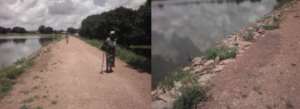
By Samuel Akapule, GNA
Bolgatanga, Sept. 24, GNA - The Ghana Social Opportunities Project (GSOP) has rehabilitated 67 dams and dugouts in communities in the Upper East Region to assist rural famers to undertake dry season farming.
Most of the rehabilitated dams were completely broken down but had been reinstated to an improved state.
Activities undertaken on them included improvements to the earth embankments, rip rapping and planting of vertiva grass to protect the upstream and downstream slopes from erosion respectively, de-silting of the reservoir areas, widening and restoring spillway structures as well as repairs to irrigation structures.
Mrs Adwoa Asotia-Boakye, the Regional Coordinator of GSOP, said this when she undertook a monitoring visit with some journalists to some of the rehabilitated dams' sites.
The Upper East Region falls within the Sudan Savanna zone which is characterised by a short rainfall period, lasting about five months and a long dry period of seven months.
Predominantly farmers, household food security becomes a major problem due to the unfavorable climatic conditions coupled with low soil fertility.
This phenomenon accounts for the rural urban migration which is high in the region as many people from the area especially the youth and women have to travel to either Kumasi or Accra to do menial jobs leaving the aged behind.
The Regional Coordinator of GSOP said it was to help address the above phenomenon that the Government through GSOP initiated the rehabilitation of the dams and dugouts.
She said the rehabilitation of the dams, under the Labour Intensive Public Works (LIPW) component of GSOP sought to provide targeted poor rural households with access to employment and income-earning opportunities.
'It sets out to maximize local employment while rehabilitating productive infrastructure assets, which have the potential to generate local secondary employment effects and, protect households and communities against external shocks. Typical LIPW sub-projects include rehabilitation and maintenance of rural feeder and access roads, rehabilitation of small earth dams and dugouts, climate change mitigation interventions and related public infrastructure', Mrs Asotia-Boakye said.
She said apart from the community members being temporarily employed and earning cash, the secondary benefits include the use of the dams for dry season farming, provision of water for livestock, building and maintenance of local housing structures among others.
'Labour intensive methods of construction were used to engage 18,458 community members who earned a total of GHC 7,749,026 as wages over the past four years', Mrs Asotia-Boakye said.
The Ghana Social Opportunities Project which is funded by the World Bank and the Government of Ghana begun in the Upper East Region in 2011.
Implementation of the Labour Intensive Public Works component of the Project is being undertaken through the various District Assemblies with facilitation and technical support from the Bolgatanga Regional Coordinating Office (BRCO) of GSOP.
According to the Regional Coordinator, the Project has to date engaged over 42,349 unskilled persons from the rural communities in the Upper East region to rehabilitate their feeder roads to improve access to dams and dugouts, schools and clinics as well as Climate Change mitigation interventions such as re-afforestation, establishment of plantations of fruit trees and other woodlots.
Among some of the dam subproject sites visited were the Kayilo and Asunia dams both in the Kassena-Nankana West District.
The chiefs and people in the beneficiary communities expressed their gratitude to the project managers, Government and the World Bank saying it would help contribute significantly to the improvement of the livelihoods of the people.
GNA




 2024 election will be decided on the grounds of the economy; choice of running m...
2024 election will be decided on the grounds of the economy; choice of running m...
 Dumsor: We're demanding less; just give us a timetable — Kwesi Pratt to ECG
Dumsor: We're demanding less; just give us a timetable — Kwesi Pratt to ECG
 Do I have to apologise for doing my security work, I won’t – Simon Osei-Mensah r...
Do I have to apologise for doing my security work, I won’t – Simon Osei-Mensah r...
 Prestea and Bogoso mines: Complete payment of outstanding salaries not later tha...
Prestea and Bogoso mines: Complete payment of outstanding salaries not later tha...
 NDC postpones Prof. Opoku-Agyemang entry tour to May
NDC postpones Prof. Opoku-Agyemang entry tour to May
 All my businesses have collapsed under Akufo-Addo — NDC Central regional chair
All my businesses have collapsed under Akufo-Addo — NDC Central regional chair
 Military, Prison Officers clash in Bawku, three injured
Military, Prison Officers clash in Bawku, three injured
 GRA-SML contract: MFWA files RTI request demanding KPMG report
GRA-SML contract: MFWA files RTI request demanding KPMG report
 Court threatens to call second accused to testify if NDC's Ofosu Ampofo fails to...
Court threatens to call second accused to testify if NDC's Ofosu Ampofo fails to...
 Family accuses hospital of medical negligence, extortion in death of 17-year-old...
Family accuses hospital of medical negligence, extortion in death of 17-year-old...
